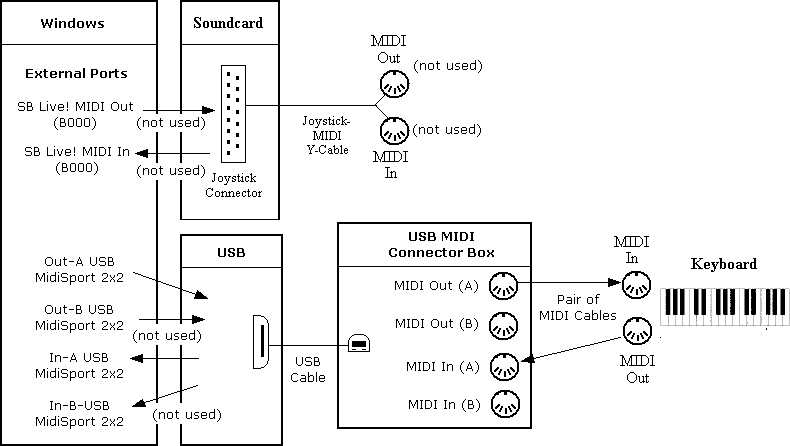|
<< Click to Display Table of Contents >> Common MIDI Device Configurations |
  
|
|
<< Click to Display Table of Contents >> Common MIDI Device Configurations |
  
|
Most modern MIDI devices are "plug and play" using USB connections that do not require any manual manipulations or much attention on the part of the user. If you have older devices, however, you may need to check out this section.
This topic shows diagrams and corresponding MIDI Device Configuration Windows for some common MIDI device configurations. Your configuration might exactly or closely match one of these configurations. If not, you may find similarities that will help you correctly inform Musician about your MIDI equipment in the MIDI Device Configuration Window.
All of the examples illustrate two versions of MIDI drivers for Soundblaster sound cards. Recent Soundblaster sound cards define a single "SB Live! External MIDI" or "SB Live! MIDI UART" external port that handles both MIDI In and MIDI Out. Somewhat older Soundblaster sound cards define two separate external ports, one for MIDI In and one for MIDI Out. sound cards by other manufacturers similarly have either a single external port for MIDI In and MIDI Out, or else separate MIDI In and MIDI Out ports.
Most of the examples illustrate the connection of a joystick-MIDI Y-cable to the sound card joystick connector. The last example illustrates a USB MIDI connector box, which connects to a USB connector of the computer. In that case, the MIDI drivers for the USB MIDI connector box provide the MIDI input and output ports; and the external input and output ports of the sound card remain unused.
All of the examples of MIDI Device Configuration Windows show two internal output ports, named "A: SB Live! MIDI Synth" and "B: SB Live! MIDI Synth". Through these two internal output ports, the Soundblaster sound card offers a total of 32 MIDI channels for playback through its software synthesizer. The diagrams in this topic do not show these internal ports; they show only the external ports and connected external devices. For a diagram of internal ports, see Understanding Ports and Devices in the MIDI Device Configuration Window.
1. Single sound card external port for MIDI In and MIDI Out; joystick-MIDI Y-cable; and MIDI keyboard that can play back MIDI.
This diagram is the same as part of the diagram shown in Understanding Ports and Devices in the MIDI Device Configuration Window.

![]()
2. Two separate sound card external ports for MIDI In and MIDI Out; joystick-MIDI Y-cable; and MIDI keyboard that can play back MIDI.
In this example, "B000" is the Windows port address, which is not information you would normally need to know.

![]()
3. Two separate sound card external ports for MIDI In and MIDI Out; joystick-MIDI Y-cable; MIDI controller keyboard that can produce sound only through the computer
In this example, the external output port is not used. Musician initially assigns a placeholder external device to the external port, with a name that starts with the words "External Device Connected to", followed by the name of the external port. In this example, the placeholder external output device woud be named "External Device Connected to SB Live! IMIDI Out (B000)". If your MIDI contoller keyboard is not capable of playing back MIDI, then it is a good idea to delete this placeholder external output device. Then you will not see it listed as an option for assignments of output devices to the staff. For instructions in deleting a device, see Removing a Device.
![]()
![]()
4. USB MIDI connector; MIDI keyboard that can play back MIDI
In this example configuration, the sound card's external MIDI In and MIDI Out ports are not used. The MidiSport(tm) 2x2 USB MIDI connector box provides two MIDI In connectors and two MIDI Out connectors, but in this example, only one MIDI In and one MIDI Out connector are used.
In this example, placeholder devices have been deleted for the ports "SB Live! MIDI UART", "Out-B USB MidiSport 2x2" and "In-B USB MIdiSport 2x2". See the explanation for deleting placeholder devices in the previous example.

![]()